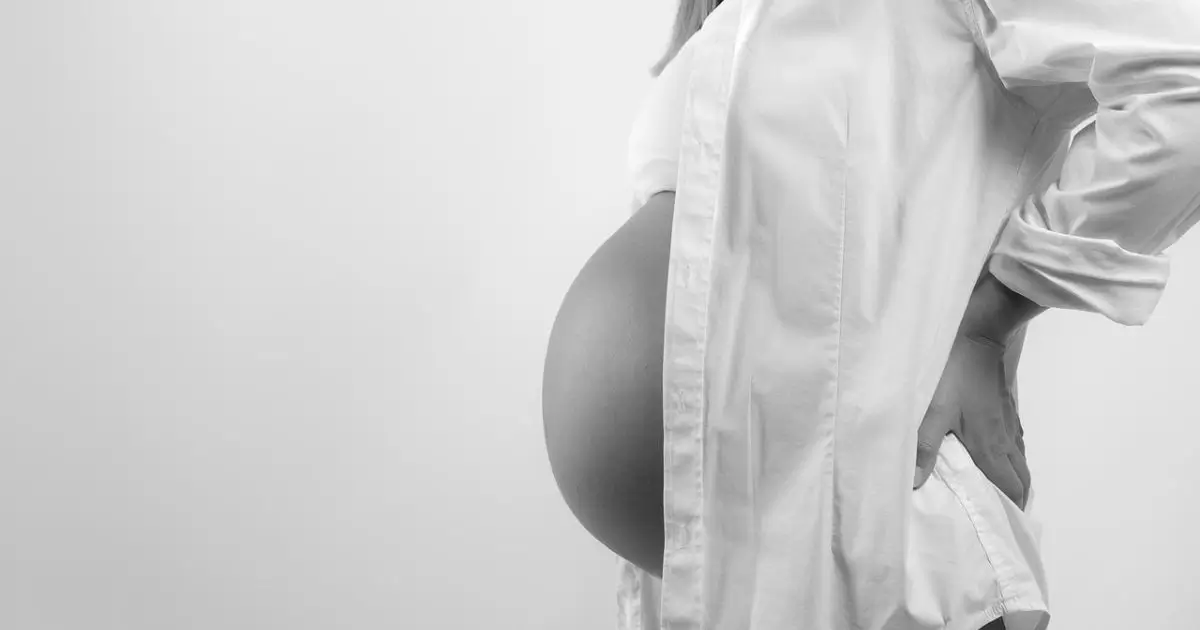Experiencing Pregnancy Pain in the Coccyx is a common issue that many women face during pregnancy. This discomfort, often referred to as tailbone pain during pregnancy, typically occurs as the body adapts to the changes needed for carrying a baby. While this pain can be alarming, it is generally not a serious condition. However, understanding its causes, symptoms, and effective treatments can help alleviate the discomfort and help you enjoy your pregnancy more comfortably.
In this detailed guide, we’ll explore everything you need to know about pregnancy pain in coccyx, from its causes to how you can manage it. Whether you’re in your first trimester or nearing your due date, we’ll help you understand how to deal with this common pregnancy-related pain.
Table of Contents
What is Pregnancy Pain in Coccyx?
Pregnancy pain in coccyx refers to discomfort or pain in the tailbone area (coccyx) that women often experience during pregnancy. This condition can range from a dull ache to sharp, debilitating pain and is often aggravated by sitting or standing. It’s generally caused by the physical and hormonal changes occurring in your body as it prepares for childbirth.
While this pain is unpleasant, it’s usually a temporary condition that will subside after the baby is born. That said, understanding the root causes of pregnancy pain in coccyx is essential for managing it effectively and minimizing discomfort.
Why Does Pregnancy Pain in Coccyx Happen?
Several factors contribute to tailbone pain during pregnancy, with the most common being hormonal changes, postural adjustments, and pressure from the growing uterus. Let’s take a closer look at the primary reasons for pregnancy pain in coccyx:
1. Hormonal Changes and Relaxin
One of the primary causes of pregnancy pain in coccyx is the hormone relaxin. During pregnancy, your body produces more relaxin to loosen ligaments and prepare the pelvis for childbirth. While this is beneficial for labor, it also affects the ligaments around the coccyx, making them looser and more prone to pain or injury. As a result, tailbone pain during pregnancy can occur.
2. Increased Pressure on the Pelvis
As your pregnancy progresses, your uterus grows larger, placing more pressure on the pelvic region. This additional pressure can affect the coccyx, leading to pain. The more weight your body carries, the more pressure it exerts on the tailbone area, which can worsen pregnancy pain in coccyx as the pregnancy continues.
3. Postural Shifts and Weight Gain
Pregnancy leads to significant changes in your body’s posture. As your baby grows, you may unconsciously alter your posture to support the added weight in your abdomen. This shift often results in increased pressure on the lower back and tailbone, exacerbating pregnancy pain in coccyx. Additionally, weight gain during pregnancy can intensify this discomfort.
4. Preparation for Childbirth
As your body prepares for labor, the pelvic joints and ligaments begin to loosen, which can cause discomfort in the coccyx region. This loosening of joints is essential for delivery but can also trigger tailbone pain during pregnancy, especially as the body gets closer to the final stages of pregnancy.
5. Postural Stress and Sitting for Long Periods
Many women experience pregnancy pain in coccyx because of poor posture or prolonged sitting. During pregnancy, you may find it difficult to sit comfortably for long periods, particularly on hard surfaces. The added pressure on the coccyx, combined with a change in posture, can worsen the pain over time.
Common Symptoms of Pregnancy Pain in Coccyx

If you’re experiencing pregnancy pain in coccyx, it’s helpful to recognize the symptoms so you can take appropriate steps to alleviate the discomfort. The typical symptoms include:
- Dull or Sharp Pain: You may experience pain that is either a dull ache or sharp, stabbing sensations in the tailbone area.
- Discomfort While Sitting: Many women feel more pain when sitting for long periods, especially on hard chairs or surfaces.
- Pain When Moving: Activities such as standing up, walking, or transitioning from sitting to standing can aggravate pregnancy pain in coccyx.
- Increased Pain During Later Stages: Tailbone pain during pregnancy often intensifies as you enter the second and third trimesters.
Recognizing these symptoms can help you identify whether the discomfort you’re feeling is related to pregnancy pain in coccyx or another condition.
How to Relieve Pregnancy Pain in Coccyx
While pregnancy pain in coccyx is generally manageable, there are a number of ways to alleviate the discomfort. Here are some proven strategies to reduce tailbone pain during pregnancy:
1. Maintain Proper Posture
Maintaining good posture is key to reducing pregnancy pain in coccyx. Avoid slouching, which places additional pressure on the lower back and coccyx. Try to stand up straight, engage your core muscles, and avoid leaning too far back. Sitting with a straight spine will also help prevent exacerbating tailbone pain during pregnancy.
2. Use a Supportive Cushion
Sitting for extended periods can make pregnancy pain in coccyx worse. Consider using a coccyx cushion or a specially designed pregnancy pillow that provides support for your lower back and tailbone area. These cushions are designed to relieve pressure from the coccyx and promote better posture while sitting.
3. Take Frequent Breaks
If you’re sitting for long stretches, make sure to take breaks regularly. Stand, walk around, or change positions to relieve pressure on your tailbone. This will help prevent pregnancy pain in coccyx from becoming more severe.
4. Apply Heat or Ice
Both heat and cold treatments can help manage tailbone pain during pregnancy. Apply a warm compress or heating pad to relax the muscles around the coccyx. Alternatively, ice packs can help reduce inflammation and numb the pain, especially if the discomfort is sharp.
5. Stretch and Strengthen
Gentle stretching exercises can relieve tension in the lower back and pelvis, which helps to reduce pregnancy pain in coccyx. Pelvic tilts and tailbone stretches are effective ways to reduce pressure on the coccyx and improve flexibility in the affected area.
6. Seek Chiropractic Care
Prenatal chiropractic care is another excellent option for managing pregnancy pain in coccyx. A chiropractor trained in prenatal techniques can perform adjustments to the pelvis and spine to alleviate pressure on the coccyx and improve overall alignment.
7. Try Physical Therapy
If your tailbone pain during pregnancy persists, a physical therapist may be able to help. Physical therapy focuses on strengthening the muscles around the coccyx, which can help reduce pressure and prevent the pain from recurring.
When Should You See a Doctor?
In most cases, pregnancy pain in coccyx is temporary and not a cause for concern. However, there are instances when you should consult a doctor:
- Severe or Persistent Pain: If the pain doesn’t improve or worsens over time, it’s important to see your healthcare provider.
- Radiating Pain: If the pain radiates down your legs or is accompanied by numbness or tingling, it may indicate another issue that requires attention.
- Difficulty Moving: If the pain makes it hard to stand, walk, or sit comfortably, seeking medical advice is a good idea.
While tailbone pain during pregnancy is usually a benign condition, your doctor can help rule out other causes and suggest treatments to relieve the discomfort.
FAQ: Pregnancy Pain in Coccyx
1. What causes pregnancy pain in coccyx?
Pregnancy pain in coccyx is commonly caused by hormonal changes, increased pressure from the growing uterus, postural shifts, and weight gain. These factors place additional stress on the tailbone, leading to discomfort.
2. How can I relieve tailbone pain during pregnancy?
You can relieve pregnancy pain in coccyx by maintaining good posture, using supportive cushions, applying heat or ice, stretching, and seeking chiropractic or physical therapy care.
3. When should I see a doctor about tailbone pain during pregnancy?
If pregnancy pain in coccyx becomes severe or radiates down your legs, or if it interferes with your daily activities, consult a doctor to ensure there are no underlying complications.
4. Is tailbone pain during pregnancy permanent?
No, pregnancy pain in coccyx is usually temporary. It often subsides after childbirth, but in some cases, the pain may persist or require further treatment.
5. Can tailbone pain during pregnancy affect labor?
Tailbone pain during pregnancy generally does not affect labor. However, if the pain persists after birth, it may be worth investigating further with your doctor.
Pregnancy pain in coccyx is a common condition that many women face during pregnancy, but it is generally not a cause for concern. With the right strategies, such as posture adjustments, support cushions, and exercises, you can manage tailbone pain during pregnancy effectively
